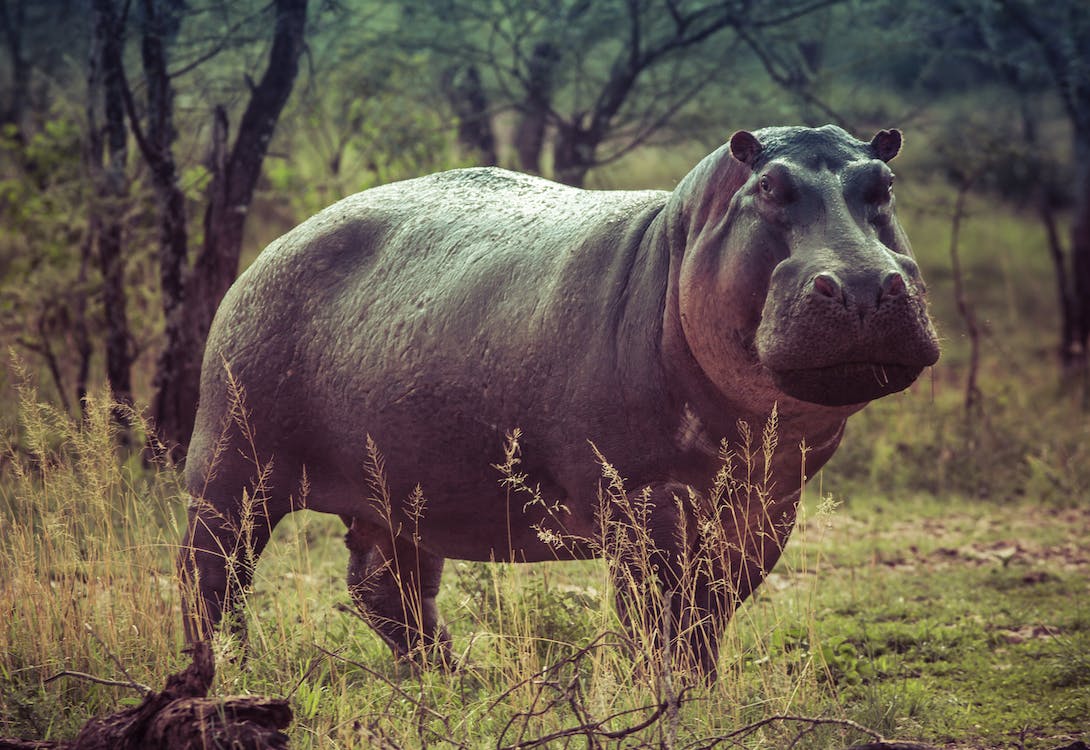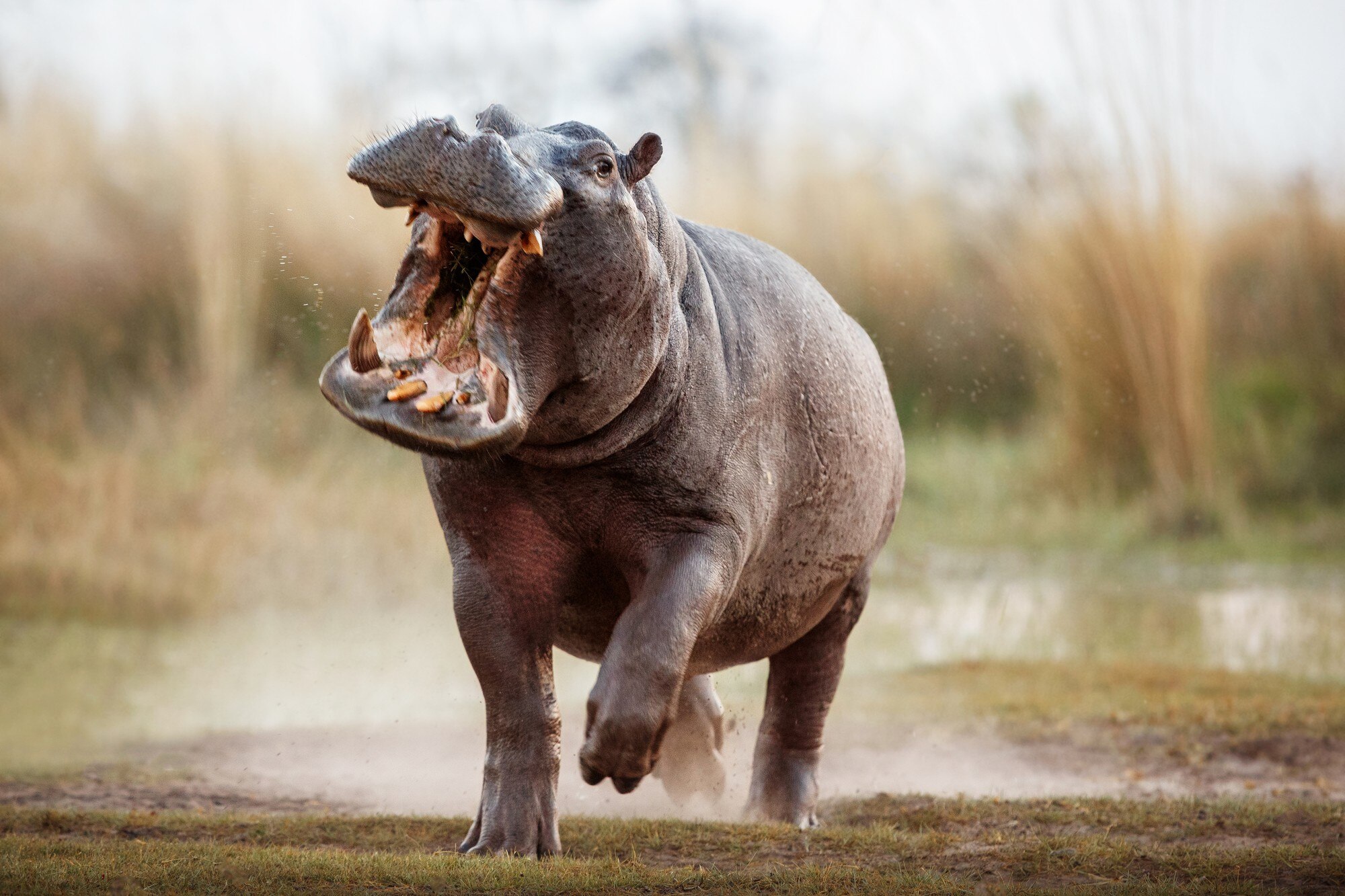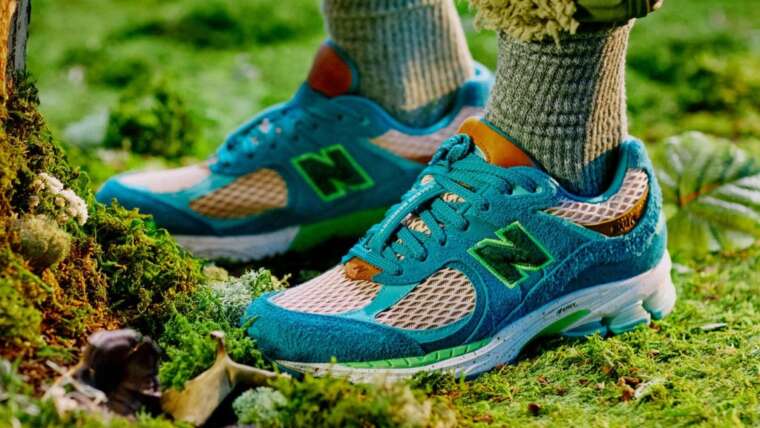A hippo’s running speed might surprise you. These massive mammals can sprint at 30 km/h (19 mph) over short distances, even though they weigh up to 1,500 kg (3,300 lbs). The sight of a running hippo becomes even more remarkable as they become airborne at full speed, with all four feet leaving the ground simultaneously.
Most humans run at 10–13 km/h (6–8 mph), making them easy targets for these deceptively agile creatures. The hippo’s prowess extends beyond land—they slice through water at speeds reaching 12 mph. Their deadly combination of speed and power helps explain why hippos claim 500–3,000 human lives each year, surpassing the death toll from lions, crocodiles, and elephants combined.
Let’s break down the shocking capabilities of these three-ton speedsters as they move across land and water. This piece will explore their remarkable physical adaptations that enable such impressive speeds. We’ll also look at their running behavior and understand why their unique mix of size, speed, and temperament makes them one of Africa’s most feared animals.

Table of Contents
- 1 How fast can a hippo run on land?
- 2 What makes hippos so fast despite their size?
- 3 How fast can a hippo run in water?
- 4 Why do hippos run?
- 5 Are hippos dangerous to humans?
- 6 Here are some FAQs about how fast can a hippo run:
- 6.1 Can a person outrun a hippo?
- 6.2 Which runs faster, Rhino or hippo?
- 6.3 Can hippos run 30 mph?
- 6.4 Are hippos faster in water or on land?
- 6.5 What animal is a hippo afraid of?
- 6.6 Can a hippo’s jaw fit a car?
- 6.7 Can hippo skin stop a bullet?
- 6.8 Which animal has 20,000 bite force?
- 6.9 What to do if chased by a hippo?
How fast can a hippo run on land?
These massive hippos can move at speeds that don’t match their bulky looks at all. They show amazing bursts of speed on land.
Top speed of a hippo in mph
Hippos can move at amazing speeds even though they weigh up to 1,500 kg (3,300 pounds). Most sources agree that these giants can reach speeds of 30 km/h (19 mph) in short bursts. This makes them one of the fastest animals for their size.
The way hippos run is quite amazing. At their fastest, they spend about 15% of their time off the ground completely. All four feet leave the ground at once, making them move like a galloping horse – which matches their Greek name “river horse”.
Some sources say hippos hit speeds of 30 km/h, but Wikipedia points out this hasn’t been proven yet. All the same, many wildlife experts and safari guides stick to the 19 mph figure.
How hippo speed compares to humans
The numbers don’t look good if you ever end up racing a hippo. Most people run at speeds between 10–13 km/h (6–8 mph). A charging hippo would catch up to them easily.
Athletes in good shape can sprint at 24 km/h, but that’s nowhere near enough to outrun a hippo. Here’s a quick breakdown:
- Average human: 10-13 km/h (6-8 mph)
- Trained athlete: ~24 km/h (15 mph)
- Hippo: 30 km/h (19 mph)
Usain Bolt might be your only hope in this race. He hit 44.7 km/h (27.8 mph) during his record-breaking 100-meter sprint. Unless you’re the fastest person alive, you won’t outrun a hippo.
One wildlife expert puts it straight: “I would not advise experimenting” with trying to outrun these beasts. Their four powerful legs and massive body make the race outcome pretty clear – and humans won’t win.
How long can they maintain top speed
These giants can move fast but they run out of steam quickly. Wildlife experts say hippos keep their top speed for about 30 seconds before they tire out.
Some experts think they might run out of energy even faster – maybe in less than 30 seconds. Moving such a huge body at high speeds burns through energy fast.
On top of that, hippos hit top speeds only on flat ground. They can speed up to 30 km/h in just a couple of seconds. This quick burst of speed makes them extra dangerous up close.
Their unexpected speed bursts, fast acceleration, and aggressive nature make hippos really dangerous. Most people can’t outrun them even for short distances. They might not run for long, but they don’t need to – a few seconds is enough to catch someone who gets too close.

What makes hippos so fast despite their size?
Hippos might look slow because of their huge size, but these giants can reach amazing speeds. They can run up to 30 km/h (19 mph) thanks to some remarkable physical features that make their movement more efficient.
Powerful leg muscles and body structure
Many people think hippos are just fat, but that’s not true. Their bodies are mostly lean muscle covered by waterproof skin about two inches thick. Their skeleton is a masterpiece of nature’s engineering that supports their massive weight and lets them move easily.
These animals have strong bones that help them move both on land and in water. Their muscle structure gives them surprising agility for their size. A hippo’s muscle fibers are arranged in a special way that supports their huge body mass and creates a perfect balance between strength and stability.
Their powerful leg muscles pack enough force for quick bursts of speed. Though their legs look short, they’re packed with strength that can support their 1,500 kg (3,300 pound) bodies and help them accelerate quickly.
Unique trotting gait and footfall pattern
Hippos move differently from most large mammals. Scientists have found that they only use a trotting gait no matter how fast they go. This means their diagonal legs move together—left back with right front, then right back with left front.
They keep this trotting pattern whether they’re walking slowly or running full speed. This makes hippos special since they’re among the few four-legged animals that only trot instead of switching between walking, trotting, and galloping as they speed up.
Scientists made an amazing discovery about hippo movement. When running at top speed, hippos actually go airborne with all four feet off the ground for about 0.3 seconds, which happens during 15% of each stride. This brief “flying” phase is incredible for such a heavy animal.
Weight distribution and toe-walking
Here’s another surprise—hippos walk on their toes. Each foot has four toes with sharp hooves that grip well on different surfaces, from mud to grass and slippery ground.
This toe-walking is nature’s way of helping animals move efficiently. Standing upright on their toes has several benefits:
- It helps handle the stress on bones and muscles that comes with being so heavy
- It saves energy compared to other ways of walking
- It spreads their weight better for good balance
Research shows that a hippo’s front feet carry about 60% of their weight. This forward-balanced position helps them move more efficiently.
Rise of speed abilities
Hippos needed to become fast to survive. Their speed helps them escape danger or protect their territory. A running hippo usually means it feels threatened.
Scientists think that walking on toes might have helped some animals grow larger over time. This link between foot position and size hints at how hippos got so big while staying surprisingly fast.
These animals are versatile too. They use similar movements underwater, trotting along river bottoms instead of swimming. This shows how nature’s adaptations work well both on land and in water.
The mix of strong muscles, unique movement patterns, and special weight distribution creates an efficient system. That’s why these three-ton animals can reach speeds that still amaze both researchers and wildlife watchers.
How fast can a hippo run in water?
Hippos show movement patterns in water that challenge most people’s expectations of such massive mammals. These giants have fascinating adaptations that help them traverse rivers and lakes with ease, despite their physical limitations.
Why hippos can’t swim
Most people would be surprised to learn that these semi-aquatic mammals cannot actually swim. These massive creatures lack the physical capacity to swim in any traditional way. Their extreme body density makes them too heavy to float. A hippo’s dense bone structure and massive weight force it to sink rather than stay buoyant.
Unlike other water-dwelling mammals, hippos don’t have streamlined bodies, fins, or flippers that make swimming easier. Nature never gave them swimming abilities during their rise. They adapted other ways to move through water instead.
How they move underwater
These remarkable creatures developed a unique technique to move through water. They “run” or “trot” along riverbeds and lake bottoms. Their underwater movement looks like a slow-motion gallop, and they lightly touch the bottom with their slightly webbed toes.
Deep waters require hippos to use several distinct movement methods:
- Walking or galloping directly on the riverbed in shallow areas
- Using porpoise-like leaps in deeper sections, pushing off the bottom
- Bouncing and gliding with surprising grace despite their enormous size
Air breaks happen every 3-5 minutes. A hippo pushes up from the bottom, takes a breath, and sinks back down to continue its underwater trip.
Speed of hippos in water
These giants can move at speeds up to 8 km/h (5 mph) underwater. Their powerful legs push off the bottom to create this impressive pace. While this speed falls short of their land speed of 30 km/h (19 mph), it’s remarkable since they achieve it without traditional swimming.
Dense bones help them stay submerged as they guide themselves through water. Their bodies come equipped with special features that boost underwater mobility, like nostrils and ears that seal shut while submerged.
River bottoms serve as underwater highways for these massive mammals. They use the same trotting motion underwater as they do on land, which lets them move smoothly between both environments despite not swimming like other aquatic animals.
Why do hippos run?
A hippo’s impressive speed stems from specific behavioral motivations that drive these massive mammals to run. Understanding these reasons gives us significant insight into their survival strategies.
Escaping predators
Adult hippos rarely need to escape predators because of their imposing size. Their massive bulk means they have few natural enemies. Young hippos face real threats from lions, crocodiles, hyenas, and leopards. Their speed of 19 mph helps them flee to water—their safe zone.
These animals escape their enemies by heading to water when threatened. Young hippos face one of their biggest threats from other hippos, as territorial fights between adults can turn deadly for calves caught in between.
Defending territory
These animals use their surprising speed to defend their territory. They show fierce territorial behavior, especially in water environments. Males control stretches of 50-100 meters of river or 250-500 meters of lakeshore as their exclusive mating grounds.
Males fight aggressively to control both space and females, leading to vicious territorial battles. Their territorial nature goes beyond other hippos—they charge at anything they see as an intruder in their domain, whether it’s an animal or human.
This aggressive behavior becomes more intense during dry seasons when water levels drop and resources become scarce. Hippos guard their remaining water territory more fiercely at these times.
Searching for food at night
Hippos leave the water after sunset to start their nightly grazing. These feeding trips usually last 5-6 hours, and they eat up to 110 pounds of grass each night.
They may travel up to five miles from water to find good grazing areas during these feeding trips. Despite their massive size, they eat a modest amount of food—just 1-1.5% of their body weight daily due to their lazy lifestyle.
Sometimes extreme conditions force hippos to travel even further. During droughts or habitat changes, they have traveled up to 30 miles to find suitable water sources. These long migrations show why hippos need the speed that makes them such powerful runners.
Are hippos dangerous to humans?
Hippos are not just fast swimmers – they are Africa’s deadliest large land mammals. Their mix of power, territorial nature, and unexpected agility makes them a deadly threat that needs respect.
Aggression and territorial behavior
Male hippos defend their territory with fierce determination. They claim 50-100 meters of river or 250-500 meters of lakeshore as their exclusive mating grounds. Their territorial behavior shows up mostly in water, not on land. These animals become more aggressive during dry seasons as water sources get crowded. Female hippos with calves show remarkable defensive skills. They often beat bulls in fights by attacking from the side. The fights feature dramatic displays – tusk clashing, rearing up, pushing with lower jaws, and violent biting.
Hippo attacks and human fatalities
The death toll tells a grim story. Hippos kill between 500-3000 humans each year. This number is higher than deaths from lions, leopards and crocodiles combined. Hippo attacks are deadly – with fatality rates from 29% to 87%. This is a big deal as it means that hippo attacks are far more lethal than grizzly bear attacks (4.8%), shark attacks (22.7%), or crocodile attacks (25%). A hippo’s massive jaws can split a human body in half with one bite.
Tips to stay safe around hippos
Staying safe around hippos requires specific precautions:
- Keep far from water edges in hippo areas, especially at dawn and dusk
- Stay away from the space between a hippo and water
- Watch for warning signs – an open-mouthed “yawn” shows aggression, not tiredness
- Tap the boat’s side to let hippos know you’re there
- Find cover behind trees or rocks if a hippo charges – you can’t outrun their 30 mph speed
Hippos stand out as one of nature’s most fascinating paradoxes. These powerful animals can reach speeds of 30 km/h (19 mph) on land despite their massive three-ton frames—quick enough to outrun most humans. On top of that, these giants have adapted well to water environments even though they can’t swim. They use a unique underwater trotting technique and move at 8 km/h (5 mph).
These enormous mammals’ physical adaptations tell a remarkable story. Their powerful leg muscles work with specialized weight distribution and a unique trotting gait. This combination lets them become airborne at full speed. Their territorial instincts and aggressive nature make this speed even more dangerous.
So hippos have earned their place among Africa’s deadliest large mammals. They cause hundreds, maybe even thousands, of human deaths each year. Their mix of size, speed, and unpredictable aggression means you just need to stay alert in their habitat. These giants employ their impressive speed with deadly precision, whether they protect territory, escape threats, or start their nightly feeding trips.
The next time you see these seemingly peaceful giants relaxing in a river, note that looks can fool you. A three-ton speedster lurks beneath that calm exterior, ready for explosive bursts of movement. This shocking reality about hippo speed shows us that nature’s appearances can be dangerously misleading.
Here are some FAQs about how fast can a hippo run:
Can a person outrun a hippo?
No, a person cannot outrun a hippo. Knowing how fast a hippo can run on land reveals they can reach speeds of up to 30 mph, which is much faster than even the fastest human sprinter.
Which runs faster, Rhino or hippo?
A rhino runs faster than a hippo, with some rhino species reaching 35 mph compared to a hippo’s top speed of about 30 mph. Understanding how fast can a hippo run mph puts this into perspective, as both are surprisingly fast for their massive size.
Can hippos run 30 mph?
Yes, hippos can run approximately 30 mph for short distances on land. This impressive speed for such a large animal answers the question of how fast can a hippo run and makes them incredibly dangerous when charging.
Are hippos faster in water or on land?
Hippos are more agile and arguably more efficient in water, where they can walk along the bottom or gracefully propel themselves. However, when comparing maximum speeds, how fast can a hippo run on land at nearly 30 mph is faster than their aquatic movement.
What animal is a hippo afraid of?
Hippos are typically wary of elephants and large crocodiles, though they have few natural predators as adults. Their speed, demonstrated by how fast a hippo can run, combined with their powerful jaws, makes them a formidable opponent for most animals.
Can a hippo’s jaw fit a car?
No, a hippo’s jaw cannot fit a car, though it can open to an impressive 150 degrees. Their jaw strength is more notable than its size, capable of generating immense bite force rather than accommodating large objects.
Can hippo skin stop a bullet?
Hippo skin is very thick and tough, up to 2 inches thick in places, but it cannot stop a bullet from a high-powered rifle. Their skin does provide protection from most animal attacks and minor injuries, complementing their defensive capabilities along with how fast can a hippo run to charge threats.
Which animal has 20,000 bite force?
The saltwater crocodile has the strongest recorded bite force of approximately 20,000 psi. While hippos have an incredibly powerful bite estimated around 1,800 psi, it doesn’t compare to the crocodile’s record-breaking force.
What to do if chased by a hippo?
If chased by a hippo, you should run uphill or toward solid cover like a tree or building, as they struggle with elevation. Never get between a hippo and its water source, and remember that knowing how fast can a hippo run in water and on land emphasizes the importance of finding immediate, inaccessible shelter.


